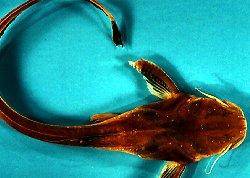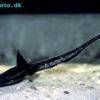Banjo - Aspredo aspredo
Scientific name: Aspredo aspredo
Common name: Banjo
Family: Aspredinidae
Usual size in fish tanks: 35 - 40 cm (13.78 - 15.75 inch)
014
Recommended pH range: 6.8 - 8.2
Recommended water hardness: 4 - 20°N (71.43 - 357.14ppm)
0°C 32°F30°C 86°F
Recommended temperature range: 22 - 27 °C (71.6 - 80.6°F)
The way how these fish reproduce: Spawning
Where the species comes from: South America
Temperament to its own species: peaceful
Temperament toward other fish species: peaceful
Usual place in the tank: Bottom levels
Food and Feeding
The Banjo Catfish (Aspredo aspredo) is an opportunistic feeder that thrives on a varied diet. In captivity, they require high-quality sinking pellets or wafers as a staple. Their diet can be supplemented with live or frozen treats such as bloodworms, blackworms, or brine shrimp. Algae wafers are a beneficial addition, particularly to mimic the small invertebrates and plant material they consume in the wild. Feeding once or twice in the evening is ideal, as these fish are primarily nocturnal feeders.
Origin
The Banjo Catfish is native to South America, inhabiting the slow-moving and brackish waters of river systems like the Orinoco delta and other rivers spanning Venezuela, Guyana, Suriname, and Brazil. They are often found in muddy or sandy substrates, where they camouflage and wait for prey, blending seamlessly into their surroundings.
Sexing
Sexing Aspredo aspredo is challenging, as there are no prominent external differences between males and females. During breeding seasons, subtle changes in behavior or size may be observed, but these are not reliable indicators for aquarists.
Breeding
Breeding the Banjo Catfish in captivity remains extremely rare, with no reported successful cases. In the wild, females are known for their unique reproductive behavior, incubating eggs on their belly. The adhesive eggs attach to the female’s underside, where she carries them until hatching. This behavior is adapted to protect the eggs from predation and shifting substrates. Replicating the natural conditions that encourage this breeding behavior is difficult in home aquariums, but researchers have observed it in controlled environments.
Lifespan
With proper care, the Banjo Catfish can live between 10-15 years. Maintaining stable water conditions, a nutritious diet, and a stress-free environment significantly contributes to their longevity.
Tank Requirements
The Banjo Catfish is a bottom-dwelling species that thrives in well-maintained aquariums with soft, sandy substrates to accommodate their burrowing and camouflaging habits. A tank size of at least 200 liters (53 gallons) is recommended for a single specimen due to their adult size, which ranges between 35-40 cm (13.78-15.75 inches). Add ample hiding places using rocks, driftwood, and caves to create a secure and naturalistic environment.
Maintain water conditions with a temperature range of 22-27°C (71.6-80.6°F), a pH of 6.8-8.2, and water hardness between 4-20°N. Regular water changes and good filtration are essential, as Banjo Catfish are sensitive to poor water quality. Dim lighting or the inclusion of floating plants can help create a subdued environment, replicating their natural habitats.
Suitable Tankmates
The Banjo Catfish is a peaceful species and can coexist with a variety of non-aggressive tankmates. Ideal companions include:
- Black Neon Tetras and other small characins
- Corydoras Catfish
- Small to medium-sized peaceful cichlids, like German Blue Rams
- Other bottom dwellers, such as Otocinclus and small loaches
Avoid housing them with overly aggressive or large predatory species, as this can cause stress or competition for resources.
Short Description
The Banjo Catfish (Aspredo aspredo) is a fascinating bottom-dwelling fish known for its unique flat body and excellent camouflage, resembling a piece of driftwood or a leaf. Native to South America, they thrive in aquariums with sandy substrates and plenty of hiding spots. Their peaceful temperament makes them suitable for community tanks, provided their tankmates are non-aggressive. With proper care, they can live up to 15 years, making them a rewarding addition for experienced aquarists.

 Banjo
Banjo  Banded
Banded